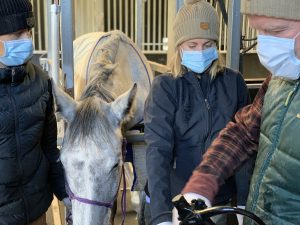An endoscopic examination of a horse’s upper respiratory tract is a procedure that allows us to view and evaluate the nasal passages, pharynx, larynx, guttural pouches and trachea (windpipe). It is used in patients to evaluate the causes of noise during exercise or rest, bleeding from the nostrils, reduced airflow from one or both nostrils, poor performance or in cases of nasal discharge. The endoscope can also be used to look into sinuses after an entry hole has been made. The system also has the ability to perform injections via endoscopic exam (eg of ethmoid haematomas) as well as collect samples of the lower respiratory tract for laboratory analysis.
Some of the more common conditions that can be diagnosed on endoscopic examination are left laryngeal hemiplagia (‘roarers’, see photo below), dorsal displacement of the soft palate (DDSP), epiglottic entrapment and ethmoid haematomas.


